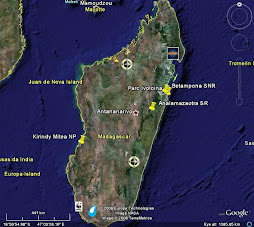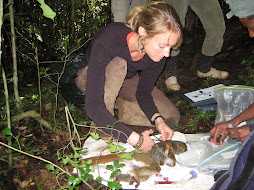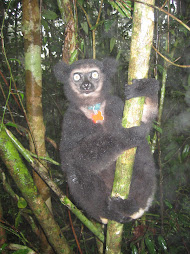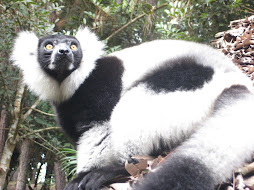This summer I'll be focusing on the smaller species, namely the mouse lemurs. But last summer and in the future I'll continue to work on
Eulemur and
Indri, who both require a little more complicated capture strategy.
People often ask just how exactly we go about catching a lemur, so I thought I might share this little video and describe the process.
The capture team, made up of a darter, a couple of spotters and 4-5 people designated as runners, walks slowly through the forest. If a lemur is spotted, the darter waits and maneuvers to get the perfect shot. The dart gun, pressurized with carbon dioxide, is fairly accurate, but you usually only get 1 chance before the lemur is long gone. No accidents here either.....in over 450 lemur captures, the Prosimian Biomedical Survey Project has not had a single lemur injury.

If the dart successfully hits the lemur (it's best in the meaty rump!) the team watches to see the lemur's reaction. I've seen some lemurs take off and cover 300 horizontal feet through the forest in a matter of seconds. Other lemurs, such as the
Indri, gaze down and wonder peacefully what has transpired. In either case, the runners of the team position themselves under the lemur and....wait. And in some cases, we wait and wait and wait. I've seen an
Indri take over an hour and a half to go under the anesthesia, but some will take just 10 minutes. See our neck muscles of steel in the picture above.
When the lemur is ready, it's grip will slip on the tree branch and we are there to catch it. This was a million dollar catch of a black-and-white-ruffed lemur from almost 100 feet up. Gol!
At this point the lemur health evaluation process begins, which takes about 40 minutes. We'll hold the lemurs (and sometimes keep them warm under our jackets) until they've fully recovered. Then they're released to their original location.
 Prepared October 13, 2008
Prepared October 13, 2008 That means Indri, so if you’re interested in their teddy-bear looks and unique,
That means Indri, so if you’re interested in their teddy-bear looks and unique, 













































.jpg)
.jpg)
.jpg)
.jpg)
.jpg)